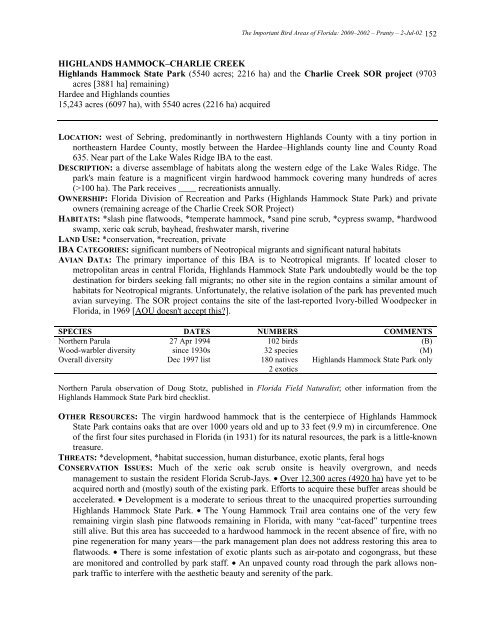The Important Bird Areas of Florida - National Audubon Society
The Important Bird Areas of Florida - National Audubon Society
The Important Bird Areas of Florida - National Audubon Society
You also want an ePaper? Increase the reach of your titles
YUMPU automatically turns print PDFs into web optimized ePapers that Google loves.
<strong>The</strong> <strong>Important</strong> <strong>Bird</strong> <strong>Areas</strong> <strong>of</strong> <strong>Florida</strong>: 2000–2002 – Pranty – 2-Jul-02 152HIGHLANDS HAMMOCK–CHARLIE CREEKHighlands Hammock State Park (5540 acres; 2216 ha) and the Charlie Creek SOR project (9703acres [3881 ha] remaining)Hardee and Highlands counties15,243 acres (6097 ha), with 5540 acres (2216 ha) acquiredLOCATION: west <strong>of</strong> Sebring, predominantly in northwestern Highlands County with a tiny portion innortheastern Hardee County, mostly between the Hardee–Highlands county line and County Road635. Near part <strong>of</strong> the Lake Wales Ridge IBA to the east.DESCRIPTION: a diverse assemblage <strong>of</strong> habitats along the western edge <strong>of</strong> the Lake Wales Ridge. <strong>The</strong>park's main feature is a magnificent virgin hardwood hammock covering many hundreds <strong>of</strong> acres(>100 ha). <strong>The</strong> Park receives ____ recreationists annually.OWNERSHIP: <strong>Florida</strong> Division <strong>of</strong> Recreation and Parks (Highlands Hammock State Park) and privateowners (remaining acreage <strong>of</strong> the Charlie Creek SOR Project)HABITATS: *slash pine flatwoods, *temperate hammock, *sand pine scrub, *cypress swamp, *hardwoodswamp, xeric oak scrub, bayhead, freshwater marsh, riverineLAND USE: *conservation, *recreation, privateIBA CATEGORIES: significant numbers <strong>of</strong> Neotropical migrants and significant natural habitatsAVIAN DATA: <strong>The</strong> primary importance <strong>of</strong> this IBA is to Neotropical migrants. If located closer tometropolitan areas in central <strong>Florida</strong>, Highlands Hammock State Park undoubtedly would be the topdestination for birders seeking fall migrants; no other site in the region contains a similar amount <strong>of</strong>habitats for Neotropical migrants. Unfortunately, the relative isolation <strong>of</strong> the park has prevented muchavian surveying. <strong>The</strong> SOR project contains the site <strong>of</strong> the last-reported Ivory-billed Woodpecker in<strong>Florida</strong>, in 1969 [AOU doesn't accept this?].SPECIES DATES NUMBERS COMMENTSNorthern Parula 27 Apr 1994 102 birds (B)Wood-warbler diversity since 1930s 32 species (M)Overall diversity Dec 1997 list 180 natives2 exoticsHighlands Hammock State Park onlyNorthern Parula observation <strong>of</strong> Doug Stotz, published in <strong>Florida</strong> Field Naturalist; other information from theHighlands Hammock State Park bird checklist.OTHER RESOURCES: <strong>The</strong> virgin hardwood hammock that is the centerpiece <strong>of</strong> Highlands HammockState Park contains oaks that are over 1000 years old and up to 33 feet (9.9 m) in circumference. One<strong>of</strong> the first four sites purchased in <strong>Florida</strong> (in 1931) for its natural resources, the park is a little-knowntreasure.THREATS: *development, *habitat succession, human disturbance, exotic plants, feral hogsCONSERVATION ISSUES: Much <strong>of</strong> the xeric oak scrub onsite is heavily overgrown, and needsmanagement to sustain the resident <strong>Florida</strong> Scrub-Jays. • Over 12,300 acres (4920 ha) have yet to beacquired north and (mostly) south <strong>of</strong> the existing park. Efforts to acquire these buffer areas should beaccelerated. • Development is a moderate to serious threat to the unacquired properties surroundingHighlands Hammock State Park. • <strong>The</strong> Young Hammock Trail area contains one <strong>of</strong> the very fewremaining virgin slash pine flatwoods remaining in <strong>Florida</strong>, with many “cat-faced” turpentine treesstill alive. But this area has succeeded to a hardwood hammock in the recent absence <strong>of</strong> fire, with nopine regeneration for many years—the park management plan does not address restoring this area t<strong>of</strong>latwoods. • <strong>The</strong>re is some infestation <strong>of</strong> exotic plants such as air-potato and cogongrass, but theseare monitored and controlled by park staff. • An unpaved county road through the park allows nonparktraffic to interfere with the aesthetic beauty and serenity <strong>of</strong> the park.
















